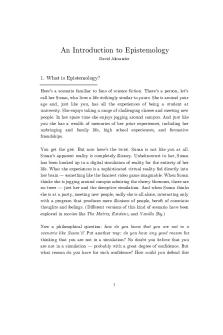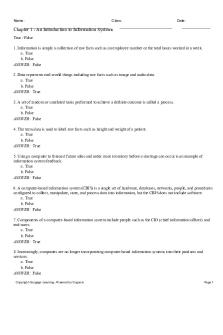BIOL 101 Chapter 1 Outline An Introduction to the Science of Life PDF

| Title | BIOL 101 Chapter 1 Outline An Introduction to the Science of Life |
|---|---|
| Author | Julie Sivilay |
| Course | Biology |
| Institution | California State University Fullerton |
| Pages | 2 |
| File Size | 64.3 KB |
| File Type | |
| Total Downloads | 90 |
| Total Views | 185 |
Summary
Chapter 1 Outline...
Description
An Introduction to the Science of Life Chapter 1 Outline 1. All living organisms share certain properties a. Biology is the scientific study of life. i. Biologists recognize life through a series of characteristics shared by all living things. ii. An object is alive if and only if it displays all of these properties simultaneously. b. The Properties of Life i. Reproduction: All organisms reproduce their own kind. ii. Growth and Development: Information carried by genes controls the pattern of growth in all organisms. iii. Energy Use: Every organism takes in energy, converts it to useful forms, and expels energy. iv. Order: Each living thing has a complex but well-organized structure. v. Cells: All living organisms consist of cell(s). vi. Response to the Environment: All organisms respond to changes in the environment. Many of these responses help to keep an organism's internal environment within narrow limits even when the external environment changes a lot. vii. Evolution: Individuals with traits that help them survive and reproduce pass the genes for those traits to offspring. Over many generations, such adaptations drive the evolution of populations. c. A virus is not alive because it does not display all of the properties for life simultaneously. d. Core Idea: Biology is the scientific study of life. All living things display a shared set of characteristics. Nonliving matter never displays all of these characteristics of life simultaneously. 2. Life can be studied at many levels a. The Levels of Biological Organization (starting from the upper end of the scale) i. Biosphere: The biosphere consists of all life on Earth and all of the environments that support life, from the deepest oceans to high in the atmosphere. ii. Ecosystem: An ecosystem includes all the living organisms in one particular area as well as the nonliving components that affect life, such as soil, air, and sunlight. iii. Community: A community consists of all the interacting populations of organisms occupying an ecosystem. This community includes plants, animals, and even microscopic organisms. iv. Population: A population is a group of interacting individuals of one species. v. Organism: An organism is an individual living being. vi. Organ System: An organ system is a group of organs that work together to perform a vital body function. vii. Organ:
3.
4.
5.
6.
7.
viii. Tissue: ix. Cell: x. Organelle: xi. Molecule: xii. Atom: b. Core Idea: Life can be studied on a hierarchy of levels from the very large to the very small. Biologists study life at all of these levels. Scientists use well-established methods to investigate the natural world a. Core Idea: Scientific investigations always start with observations, which may lead to hypotheses and experiments that provide data on the validity of the hypotheses. Careful observations and experimentation allow scientists to investigate hypotheses and develop theories. Scientists try to control for variables a. Core Idea: To most clearly investigate hypotheses, scientists try to change just one variable per experiment. An independent variable is one that is changed to see its effect on a dependent variable. Performing experiments blind can reduce bias. Scientific thinking can be distinguished from other ways of viewing the world a. Core Idea: Biology is limited to the study of life via recognized scientific approaches. Through peer review, outside authorities can help verify the validity of scientific results. Other ways of thinking, such as pseudoscience, are not considered part of biology. Scientists communicate data using tables and graphs a. Core Idea: Scientists report data using tables and graphs. You can learn to properly interpret such data because tables and graphs follow standard conventions. Several major themes run throughout the study of biology a. Core Idea: Major themes - such as evolution, the relationship of structure and function, transformations of energy and matter, the flow of information, and interconnections between elements of biological systems - unify the study of biology at all levels....
Similar Free PDFs

1. An Introduction to Epistemology
- 10 Pages

1. An Introduction to Glaciers
- 6 Pages

Introduction to science
- 11 Pages

Introduction to Food Science
- 19 Pages
Popular Institutions
- Tinajero National High School - Annex
- Politeknik Caltex Riau
- Yokohama City University
- SGT University
- University of Al-Qadisiyah
- Divine Word College of Vigan
- Techniek College Rotterdam
- Universidade de Santiago
- Universiti Teknologi MARA Cawangan Johor Kampus Pasir Gudang
- Poltekkes Kemenkes Yogyakarta
- Baguio City National High School
- Colegio san marcos
- preparatoria uno
- Centro de Bachillerato Tecnológico Industrial y de Servicios No. 107
- Dalian Maritime University
- Quang Trung Secondary School
- Colegio Tecnológico en Informática
- Corporación Regional de Educación Superior
- Grupo CEDVA
- Dar Al Uloom University
- Centro de Estudios Preuniversitarios de la Universidad Nacional de Ingeniería
- 上智大学
- Aakash International School, Nuna Majara
- San Felipe Neri Catholic School
- Kang Chiao International School - New Taipei City
- Misamis Occidental National High School
- Institución Educativa Escuela Normal Juan Ladrilleros
- Kolehiyo ng Pantukan
- Batanes State College
- Instituto Continental
- Sekolah Menengah Kejuruan Kesehatan Kaltara (Tarakan)
- Colegio de La Inmaculada Concepcion - Cebu











